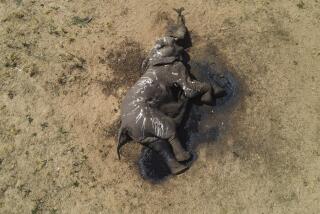Panda Population Dwindling at Nature Park, Scientists Say
- Share via
HONG KONG — The panda population at one of China’s most prestigious nature parks has declined dramatically over the preserve’s quarter-century existence--and the area’s very status as a renowned sanctuary is at least partly to blame, according to a study conducted by an international group of scientists.
The number of wild pandas in the Wolong Nature Reserve in southwestern China’s Sichuan province dropped by half--from 145 to 72--during the park’s first 11 years, and the current population is probably even smaller, say the authors of the study, headed by Michigan State University wildlife expert Jianguo Liu.
The report’s findings were published Thursday in the international journal Science.
With its distinct black-and-white coloring, the giant panda--now widely accepted in scientific circles to be a member of the bear family--is one of the best-recognized and rarest of animals. The pandas in Wolong constitute about 7% of the world’s remaining population in the wild, which Chinese environmentalists say is entirely in China.
Liu’s team found that an important cause of the decline in numbers at Wolong was the destruction of the densely forested land and bamboo undercover that make up high-quality panda habitats.
Far more strikingly, researchers also found that these prime habitats within the reserve are disappearing as fast or even faster than in unprotected areas outside the park.
Among the reasons for this apparent contradiction: tourism.
The lure of economic gain from catering to tourists, such as hotel jobs and souvenir sales, has helped spur human population growth within the park, the study found. During Wolong’s first 20 years, from 1975 to 1995, the number of households within its boundaries more than doubled to slightly more than 900.
“Tourists come, they take their summer vacations there and stimulate the local economy, which in turn uses more local natural resources,” Liu said. “We don’t see ourselves as a destructive force, but we are.”
Other factors also play a role.
“One of the local products purchased by some tourists is smoked pork,” Liu said. “Because food [from] pigs needs to be cooked using fuel wood, higher demands for smoked pork by tourists leads to more consumption of fuel wood.”
Alex Yau, conservation manager for the World Wide Fund for Nature in Hong Kong, suggested that the study’s findings could lead to a reassessment of the impact of so-called eco-tourism.
“These findings are an important audit of exactly what can happen,” she said. “Similar to eco-tourism everywhere, it [Wolong] has been so hyped and talked about that the real impact is rarely assessed. You can’t protect the giant panda without bringing the local population into the process.”
Wolong was one of the first panda preserves established in China, and its management, including patrols against poachers, has been hailed internationally as a success.
“Then it developed a tourism component,” Yau said, “and it didn’t do so well.”
Ouyang Zhiyun, a scholar at the Chinese Academy of Sciences in Beijing and a member of Liu’s team, strenuously defended the Wolong reserve, calling it “a very important conservation effort” and praising the park’s management for “doing a very good job--better than most other parks in the country.”
The real problem, he said in a telephone interview, isn’t tourism but a poor educational system that left local people with few skills to earn money outside the park.
“The most important thing is to improve levels of education so people can get jobs outside the reserve,” he said. “We have studies that show what a difference that can make.”
The Michigan State study also concluded that quality education for local children may be the best way to guarantee the park’s long-term success. But the authors also concluded that immediate steps are needed to preserve the remaining pandas.
To track the park’s changing environment, researchers used, among other data, recently declassified photos taken by NASA and U.S. military satellites.
More to Read
Sign up for Essential California
The most important California stories and recommendations in your inbox every morning.
You may occasionally receive promotional content from the Los Angeles Times.












